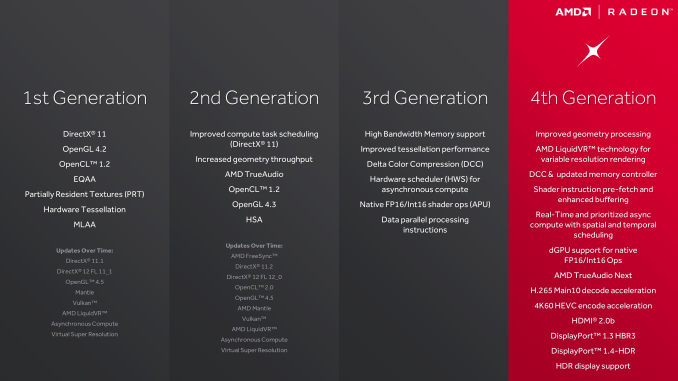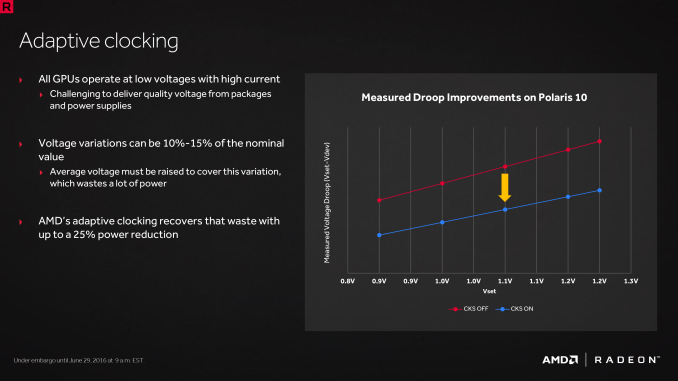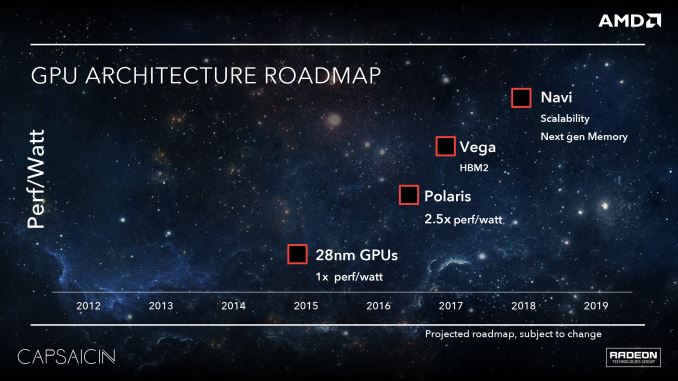The AMD Radeon RX 480 Preview: Polaris Makes Its Mainstream Mark
by Ryan Smith on June 29, 2016 9:00 AM ESTAMD's Path to Polaris
With the benefit of hindsight, I think in reflection that the 28nm generation started out better for AMD than it ended. The first Graphics Core Next card, Radeon HD 7970, had the advantage of launching more than a quarter before NVIDIA’s competing Kepler cards. And while AMD trailed in power efficiency from the start, at least for a time there they could compete for the top spot in the market with products such as the Radeon HD 7970 GHz Edition, before NVIDIA rolled out their largest Kepler GPUs.
However I think where things really went off of the rails for AMD was mid-cycle, in 2014, when NVIDIA unveiled the Maxwell architecture. Kepler was good, but Maxwell was great; NVIDIA further improved their architectural and energy efficiency (at times immensely so), and this put AMD on the back foot for the rest of the generation. AMD had performant parts from the bottom R7 360 right up to the top Fury X, but they were never in a position to catch Maxwell’s efficiency, a quality that proved to resonate with both reviewers and gamers.
The lessons of the 28nm generation were not lost on AMD. Graphics Core Next was a solid architecture and opened the door to AMD in a number of ways, but the Radeon brand does not exist in a vacuum, and it needs to compete with the more successful NVIDIA. At the same time AMD is nothing if not scrappy, and they can surprise us when we least expect it. But sometimes the only way to learn is the hard way, and for AMD I think the latter half of the 28nm generation was for the Radeon Technologies Group learning the hard way.
So what lessons did AMD learn for Polaris? First and foremost, power efficiency matters. It matters quite a lot in fact. Every vendor – be it AMD, Intel, or NVIDIA – will play up their strongest attributes. But power efficiency caught on with consumers, more so than any other “feature” in the 28nm generation. Though its importance in the desktop market is forum argument fodder to this day, power efficiency and overall performance are two sides of the same coin. There are practical limits for how much power can be dissipated in different card form factors, so the greater the efficiency, the greater the performance at a specific form factor. This aspect is even more important in the notebook space, where GPUs are at the mercy of limited cooling and there is a hard ceiling on heat dissipation.
As a result a significant amount of the work that has gone into Polaris has been into improving power efficiency. To be blunt, AMD has to be able to better compete with NVIDIA here, but AMD’s position is more nuanced than simply beating NVIDIA. AMD largely missed the boat on notebooks in the last generation, and they don’t want to repeat their mistakes. At the same time, starting now with an energy efficient architecture means that when they scale up and scale out with bigger and faster chips, they have a solid base to work from, and ultimately, more chances to achieve better performance.
The other lesson AMD learned for Polaris is that market share matters. This is not an end-user problem – AMD’s market share doesn’t change the performance or value of their cards – but we can’t talk about what led to Polaris without addressing it. AMD’s share of the consumer GPU market is about as low as it ever has been; this translates not only into weaker sales, but it undermines AMD’s position as a whole. Consumers are more likely to buy what’s safe, and OEMs aren’t much different, never mind the psychological aspects of the bandwagon effect.
Consequently, with Polaris AMD made the decision to start with the mainstream market and then work up from there, a significant departure from the traditional top-down GPU rollouts. This means developing chips like Polaris 10 and 11 first, targeting mainstream desktops and laptops, and letting the larger enthusiast class GPUs follow. The potential payoff for AMD here is that this is the opposite of what NVIDIA has done, and that means AMD gets to go after the high volume mainstream market first while NVIDIA builds down. Should everything go according to plan, then this gives AMD the opportunity to grow out their market share, and ultimately shore up their business.
As we dive into Polaris, its abilities, and its performance, it’s these two lessons we’ll see crop up time and time again, as these were some of the guiding lessons in Polaris’s design. AMD has taken the lessons of the 28nm generation to heart and have crafted a plan to move forward with the FinFET generation, charting a different, and hopefully more successful path.
Though with this talk of energy efficiency and mainstream GPUs, let’s be clear here: this isn’t AMD’s small die strategy reborn. AMD has already announced their Vega architecture, which will follow up on the work done by Polaris. Though not explicitly stated by AMD, it has been strongly hinted at that these are the higher performance chips that in past generations we’d see AMD launch with first, offering performance features such as HBM2. AMD will have to live with the fact that for the near future they have no shot at the performance crown – and the halo effect that comes with it – but with any luck, it will put AMD in a better position to strike at the high-end market once Vega’s time does come.













449 Comments
View All Comments
Meteor2 - Thursday, June 30, 2016 - link
Well, if you only want to spend $100 on the CPU and $199 on the GPU, I can...Hrel - Thursday, June 30, 2016 - link
Yeah, I can afford better. Sorry you can't yet, keep working at it!fanofanand - Thursday, June 30, 2016 - link
Arrogance doesn't play well here Captain GiantWallet. Price is a consideration for 99.9% of consumers, STFU with your one-person use case.praeses - Wednesday, June 29, 2016 - link
Seems like the RX480 should have only come with 8ghz 4GB of ram which would have yielded a slight power efficiency increase and cost reduction to move from 6pin/6phase to 8 and a better cooler. 6 should have been left for the RX470. I think marketing must have got in the way again.fanofanand - Thursday, June 30, 2016 - link
GDDR5X is still expensive. At $200 some concessions had to be made, nothing to do with marketing.tipoo - Wednesday, June 29, 2016 - link
Unfortunately for AMD, they're on completely different fabs this time than Nvidia, Glofo vs tsmc. I've wondered if that's part of their efficiency disadvantage. We've seen this with the 6S load testing. That's the thing now, with different fabs, the playing field is not even, and not only does the architecture matter, but the fab process does too when comparing them to Nvidia. Which kind of sucks for AMD.With the iPhone it mattered less because it's mostly idle, even with the screen on, but for a high performance GPU it's the full throttle aspect that matters.
Interesting though that TSMC will still make their high end parts (I don't know if that means just Vega, or the 300 dollar Polaris too), so maybe it's not all lost on the efficiency side if the fabs are to blame.
I think this is to fuffil the WSA, makes sense, higher end part gets the higher end fab, the 200 dollar part isn't particularly efficient but they hit this performance and price.
They even switched Zen to TSMC after Glofo efficiency concerns.
So I do have hope that the more expensive TSMC parts will provide them much needed efficiency to go up against Nvidias higher end, and hopefully it doesn't mean Polaris as a whole is just inefficient.
T1beriu - Wednesday, June 29, 2016 - link
1. The $300 Polaris is AIB RX480. There are no faster Polaris chips coming confirmed by Raja.2. Zen will not be built by TSMC. This was a fake rumor. GloFlo announced they're working on Zen. Source: http://www.extremetech.com/computing/217664-global...
3. A couple of months back TSMC released the list of partners building chips on 16nm. AMD wasn't on that list.
vladpetric - Wednesday, June 29, 2016 - link
It seems to me that the leadership of AMD still doesn't get it that "drivers matter" ... While NVidia does not generally make more computationally powerful cards, they spend a lot of resources on good drivers.AMD as we know it today is the marriage of two hardware-first companies (old AMD and ATI). The sad part is that after losing a lot of marketshare, market cap, etc over the last decade, good software is still a second class concern for them.
K_Space - Saturday, July 9, 2016 - link
I'm not sure what world you've been living on but RTG drivers have been head & shoulder above anything ATI or even 'old AMD Radeon' delivered. Even old GCN cards continue to benefit from these long after their sell by date.tynopik - Wednesday, June 29, 2016 - link
pg1: comfortable reach it > comfortably